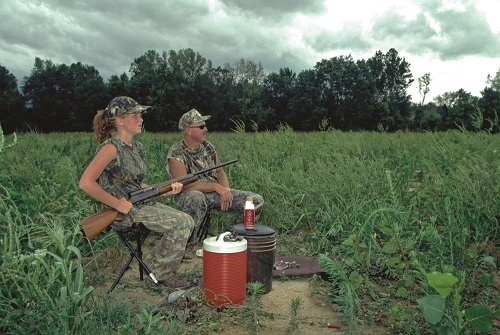 A dove comes into your section of the field on opening day. You crouch behind a row of sunflowers and excitedly wait for the dove to come into range.
A dove comes into your section of the field on opening day. You crouch behind a row of sunflowers and excitedly wait for the dove to come into range.
The dove keeps coming and you jump up, shoulder your shotgun and fire, followed by another shot and then another, none of them threatening the bird. The dove keeps flying out of the field.
The opening weekend of dove season can bring frustration to wingshooters as dove hunters, even highly experienced ones, start missing shots they normally make. The misses snowball and aggravation mounts.
“Then, when you are struggling, you tend to think more, take more time, concerned about laying the bead on the target in an effort to not miss,” said Mark Marraccini, executive staff advisor for the Kentucky Department of Fish and Wildlife Resources. “But, by doing this, you are guaranteeing you will miss.”
Sloppy fundamentals are usually the root cause of missed birds, particularly improperly mounting the shotgun. “Bad habits are easy to get into and ingrain your muscle memory,” said Marraccini, who is a competitive shotgunner and teacher of shotgun skills. “They can be hard to get rid of because you can’t see yourself shoot.”
If your upper arm and shoulder are unusually tender after a day of wingshooting, you likely mounted the shotgun too low. “There is a notch between the collarbone and the shoulder muscle,” Marraccini said. “God made that notch for a shotgun.”
Mounting the shotgun in that notch brings the top part of the stock, known as the comb, to the correct level. Improperly mounting the shotgun down the shoulder or on the upper arm causes the shooter to lower his head to the stock, a certified way to miss.
“It is much better to bring the gun to your cheek than your cheek to the gun,” Marraccini said. “It is imperative for the cheek bone to stay welded to the stock. Shooters call that ‘wood to wood.’ This also keeps the gun pointed where your eyes are looking.”
It helps to move the shotgun out in front of your body a bit and bring the butt of the gun stock straight back into that shoulder notch, instead of sliding the stock up your body when mounting your shotgun.
Marraccini also said bringing your trigger hand elbow up to roughly parallel with the ground is vitally important when shouldering a shotgun.
“Bringing that elbow up helps raise the gun to your cheek and allows for easier movement when swinging on a fast target,” he said. It is also important to keep your front elbow high as well.
Move your head forward a bit to weld the cheek a little farther down the stock toward the barrel, not back toward the butt end of the stock. The triangles formed by the gun, biceps and forearms make a firm foundation from which to shoot.
“Then, settle into a comfortable stance with feet spaced about shoulder width apart, slightly rock your weight forward and unwind into the shot as you swing on the target,” Marraccini said.
Wingshooters remember the details of great shots such as a bird’s flight, its distance and the hunting location as if they happened yesterday.
“But, you don’t remember where the barrel was,” Marraccini explained. “On great shots, you don’t see the bead, you just see the target.”
Proper gun mounting allows a shooter to focus strictly on the target. “Beads are not there for aiming, but simply for the shooter to orient to the gun,” Marraccini said. “Resist the urge to aim the bead at the target. A good shooter loses the bead once the gun is mounted properly. It is not there because they are focused on the target.”
Marraccini has a friend who says that if shotguns were invisible, nobody would ever miss. “That means don’t look at the shotgun, look at the target,” he said. “You don’t look at the hammer, you look at the nail. Your eyes should never leave the target.”
A good drill to ingrain the proper feeling is simply following a bird in flight with the first finger of the non-trigger hand. “The finger is your barrel,” Marraccini said. “You want fluid movement of your gun barrel.”
Marraccini even points the first finger of his left hand down the barrel to further ingrain this feeling. Being right handed, his left arm controls the gun swing.
“Trust your instincts and fire quickly,” he said. “If you start thinking about it and your brain gets involved, that is no good.”
Practicing the proper shotgun mount helps prevent thinking and brings about more instinctual shooting.
“Develop your fundamentals,” Marraccini said. “Going to the range and hitting clay targets is good for your fundamentals, but the flight of a dove is much more erratic. Dove shooting, as well as waterfowl and upland birds, is several levels above clays, so good fundamentals are extremely important.”
There is still plenty of dove hunting left for this license year as well as grouse, quail and waterfowl. Use these fundamentals to brush up on your wingshooting and put more birds in the bag this fall.

